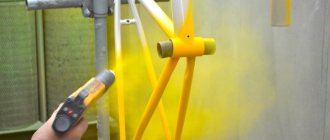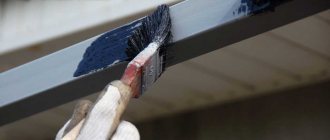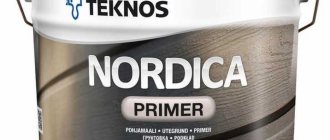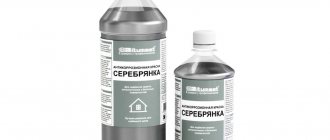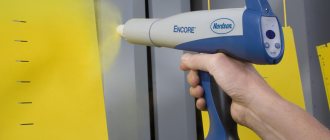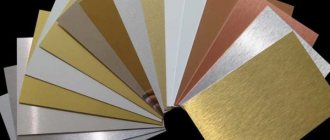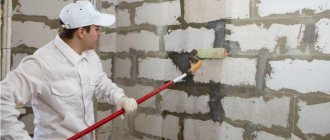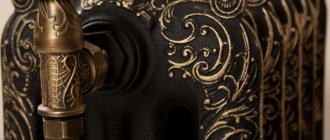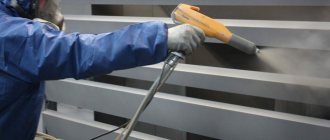Home page » Useful tips » How to paint metal
At first glance, the issue of painting metals does not pose any problems. Prepared surface, brush, paint, and your own hand. Take a brush in your hand, dip it into the paint and apply it carefully. But this is only at first glance. Already the first stage of selecting paint may puzzle you - the variety of paints on store shelves is very large. Metals are also not the same. What kind of paint do you need? Let's try to clarify this issue.
Painting metal for rust: main rules
Ecology of knowledge.
Estate: Sometimes in a matter of a year or two, or even less, seemingly new metal structures can become covered with a layer of rust. For painting such surfaces, there are paints and varnishes that can be painted without removing the rusty layer of metal. One of the main conditions for high-quality painting, including anti-corrosion painting, is careful preparation of the surface for coating. But it is not always possible to clean and prepare a metal surface covered with a layer of rust. There are special paints and varnishes that can be painted without removing the rusty layer of metal.
Quick-drying primer for metal
There is an opinion that a quick-drying primer is any priming solution that dries quickly. In fact, this statement is only partially true.
A quick-drying primer designed for treating metal surfaces requires from 20 minutes to 12 hours to dry completely. Such mixtures are created on an alkyd basis and include organic solvents. It should be noted that the drying time of conventional alkyd solutions for priming and coloring compounds takes about 2-3 days.
The product is most often used in the following applications:
Let's look at the main properties of a quick-drying mixture using the example of GF-021 soil from TEX:
Choosing paint for metal
Traditionally, oil paints were used to paint metals. Now, with the advent of modern primers, you can use acrylic paints, both regular and those that are diluted with water, as well as paints on epoxy and alkyd bases. But don't use regular water-based paint, you need those that contain anti-corrosion additives, or better yet, paints that contain rust converters and form a dense coating.
Such paints, of course, cost more than conventional alkyd or oil paints, but you will save money due to their durability. These paints have high elasticity, which does not change over time.
Features of metal painting
The best painting result will be obtained if you select the paint in accordance with the type of metal.
The most common material in the manufacture of metal structures is black iron; it becomes covered with rust very quickly, and painting is required. Both alkyd and oil paints are used to paint it. It is better to choose an alkyd primer containing chromate or phosphate (zinc compounds), then the surface of the black iron will be more reliably protected.
The galvanized surface is much more resistant to corrosion; it is widely used to cover roofs to this day, although now a wide variety of types of roofing material have appeared. A roof made of galvanized material will last up to 15 years, but if you paint it, you will increase the service life even more. In addition, the roof will look much more aesthetically pleasing.
The paint will last several seasons if you use alkyd enamel rather than oil or alkyd paint.
The need for painting non-ferrous metals arises extremely rarely. As a rule, they are varnished rather than painted. Polyurethane and epoxy varnishes can be used.
In the instructions for use supplied with the paint, manufacturers always indicate the most appropriate ways to use it. Don't forget to check it out.
Technology of work execution
We prime metal surfaces
Later in the article we will tell you what technology should be used to prime metal, including removing rust and old coating from a car or surface.
Metal priming is done as follows:
- before painting and performing work on surface treatment of a car or product, it is necessary to clean off loose layers of steel that have been corroded using a spatula;
- the remnants of old paints and varnishes are removed in the same way, but only as a result of softening with a special remover or a hair dryer (if you use a remover, wrap the product in polyethylene, which will prevent the solution from evaporating);
- rust must be removed with a brush with metal bristles or specialized attachments for hand tools (you can also purchase a special rust converter that will transform it into a durable and insoluble coating);
- to perform subsequent work, the steel must be degreased with a rag or solvent;
- metal priming is carried out in 1-2 layers using a brush, rollers, or you can use an aerosol pneumatic spray gun;
Domestic primers modifiers
Today, stores offer more than 50 types of modifier primers produced by domestic companies. You can find even more imported formulations.
Among all this diversity, we can highlight the following compositions, which over the years of practical use have shown their best performance.
Primer with corrosion converter EVA-0112
A system containing two base components, offered in separate packages - 85% phosphoric acid and a base. Before application, these components are mixed in a ratio of 3:100. The finished composition should be used within the next 24 hours. The maximum result from using this primer is guaranteed only if epoxy resin paint is applied to this coating.
Rust modifier primer EVA-01-GISI
Another two-pack system that uses 70% phosphoric acid and base. Before surface treatment, the substances are mixed in a ratio of 5-7:100. The base is polyvinyl acetate dispersion with a surfactant additive.
Rust modifier primer EP-0180
Here the basic components are the base and hardener. The primer composition begins to be prepared half an hour before application, for which the ingredients provided by this system are mixed in a ratio of 7.5:100. The finished composition remains suitable for use for 8 hours . It is suitable for treating surfaces that have been corroded unevenly. After applying this paint-primer to metal, a durable film appears that can cope with the role of a full-fledged protective coating that already has a red-brown color.
Nerzhamet-Grunt
Anti-corrosion primer based on a corrosion inhibitor and aluminum filler. They are used to treat not only structures with rust products, but also clean metal surfaces. The special composition allows it to be applied directly to traces of rust. The primer has high moisture resistance and excellent insulating ability. Can replace the topcoat; after application it forms a semi-matte film.
Primer for metal against rust - varieties
There is a whole classification of primers for metal processing, which should be considered in more detail:
- Phosphating primers. Such compositions with aqueous solutions of phosphates are best suited for treating metals without corrosive damage before painting. Firmly adhering to the base, the primer forms a slightly porous layer on which any paint and varnish material fits very well. Most often, steel is treated with phosphating primers, less often - aluminum and zinc. Paints and varnishes on various bases are perfectly compatible with such compositions: alkyd, ethinol, polyurethane, epoxy... The primer layer has a fairly high heat resistance - from 150 ° C to 220 ° C, and is also a dielectric. The color of the soil ranges from light gray to dark. A significant disadvantage of phosphating compounds is their low anti-corrosion properties. To reliably protect metal from rust, you should combine treatment with a phosphating primer and a passivating primer, which we will talk about a little further, and only then cover it with a finishing layer of paint or enamel.
- Passivating primers contain chromic acid salts, which have long-known properties of converting metals, both ferrous and non-ferrous, from an active state to a passive one, that is, the metal ceases to interact with the environment. It is very important that the concentration of chromates in the composition is sufficiently high, since with a small content of these elements you can get the opposite effect - intensify corrosion processes. For aluminum, it is better to use compositions on a dichromate basis; steel and ferrous metals are treated with ordinary chromates. Most often they contain zinc and strontium compounds, since these elements are highly soluble. The higher the concentration of chromates in the primer, the better and longer the primer layer will protect the treated surface, so before purchasing, carefully study the compositions with the indicated values. Today you will find many different mixtures: alkyd, phenolic-oil, acrylic, polyurethane, epoxy.
- Insulating primers generally contain neutral pigments, such as red lead, which form an insulating film on the surface that does not allow moisture to pass through. However, it must be taken into account that this effect is quite short-lived - once moisture penetrates under the film, corrosion processes cannot be prevented; you just need to remove the old layer, clean it of rust and apply a new one.
- Transformative primers are made for the lazy! This is, of course, humor, but, seriously, the rust does not need to be removed from the surface at all; it is enough to simply apply a transforming composition. As the name suggests, primer actually converts rust into poorly soluble compounds, or substances that quickly break down. Such primers also contain surfactants, which are necessary for easy penetration of the primer components through the layer of rust, resulting in the formation of one strong film. It is important to note that if the rust crumbles with one touch, it is still necessary to clean off at least the top layer. The same can be said about removing old layers of paint. In addition, a contaminated surface will also not create the necessary protective layer. Another disadvantage of such a primer is that by itself it will not protect the metal from further corrosion processes, so it must be combined with the same passivating compounds.
- Protective primers are so called because they contain metal powders of aluminum, zinc and magnesium, which take the full blow of possible corrosion. The higher the powder content, the better the primer will be - now they produce primers with a 90% powder content! The most famous among protective compounds are primers based on zinc dust; there are also bimetallic compounds combined with aluminum powder or red lead. Zinc, upon contact with a corrosive environment, cements the surface, and only after physical damage do further corrosion processes become possible. Aluminum powder in the primer plays a slightly different role. Since it is very light, as part of the primer it floats to the surface of the applied layer, forming a multi-layer film. As a result, aluminum powder comes into contact with a corrosive environment, and as is known, it is very resistant to this kind of influence.
Is priming necessary before painting? Why primer before putty?
It has long been known: paint does not stick to ferrous metal. Cunning technologists have come up with a way to combat the problem. A layer of primer is applied between the paint and the car body. This intermediate layer ensures the strength of the connection. On the one hand, the primer adheres tightly to the metal of the car, on the other hand, it adheres well to the paint.
Ensuring adhesion of the paint layer to the body is not the only function of the primer. Many of its types perfectly protect the car from corrosion, excluding the penetration of moisture. Even if a crack or chip appears on the top paintwork, the primer will prevent the body from rusting.
A layer of primer should be applied not only when painting pure ferrous metal, but also after repair work on a putty surface. Putty, like pure body metal, does not blend with car paint.
The only case when you don’t need to prime before painting is when working on a relatively new car on the original coating to change the color. This approach applies to cars under 1 year of age. In this case, it is enough to “roughen” the coating, that is, process it with medium-coarse sandpaper. A rough, rough surface will ensure good adhesion of the new paint coating to the old one.
Paint application process
First of all, you need to prepare your workplace. If the paint can spoil parts that will not be painted, then cover them with paper or cellophane.
If painting of metal structures is done at height, then we prepare the place. You will have to move freely. Painting of metal structures SNIP involves the following procedure for carrying out work.
Preparing metal before painting
Now let's look at how to paint metal correctly in detail. The dye should last a long time and this is precisely what depends on the quality of preparation of the base plane. To do this, you need to completely clean the surface of excess, including rust.
- First you need to clean the debris from the coating. Then you should clean off the corrosion and falling paint (see How to wash off paint without problems), it is more convenient to do this with a scraper, sandpaper or an iron sponge. Wash away dirty stains and grease, as well as other contaminants from dust.
- It is not recommended to use chemicals; it is better to use regular soap. Next, wash with plain clean water and leave to dry. If you need to paint some large and massive object, it is better to use a special burner. The paint will burn from the fire of the burner, and everything that is not needed will fall away due to corrosion products and the difference in the thermal expansion values of the metals.
- As an option, you can use a corrosion converter, but this is only in desperate and advanced cases. This is a liquid made with the addition of phosphoric acid. The surface is smeared with this solution and left for a short time, most importantly at least three hours, then washed with water and dried.
- An angle grinder with a wire brush is perfect for removing dyes from sinks. It fits into any hole. But sometimes it can partially “lick” the dye. And the remains will have to be removed with an angle grinder.
Attention: There are cases when the rust is not removed at all. Then you don’t need to worry (if you don’t need to make a high-quality and perfectly even coating), but you can simply apply paint to the surface that you were able to achieve. But the paint must have anti-corrosion additives.
Metal primer
After the surface has been thoroughly cleaned, priming is necessary. The primer is a protection against the environment, and is also used as a corrosion converter. Priming also creates good adhesion to the final coating.
Preparing metal before painting
Regardless of the type and quality of paint, the metal surface must be properly and efficiently prepared; the result of your work almost entirely depends on this. To prepare a surface means to clean it of everything that has accumulated on it.
First, remove debris from the surface. Then you need to remove the rust and old peeling paint; you can use a scraper, wire brush, emery, or even a regular metal dishwashing sponge for this purpose.
Wash away stubborn dust, dirt, oil, grease, salts, etc. But do not use abrasive products; it is better to use a regular soap solution. Then rinse the surface with clean water and let dry.
If a massive product is intended for painting, then you can use an oxygen-acetylene torch. The paint will burn from the burner flame, and scale and rust will peel off due to corrosion products and the difference in the thermal expansion coefficients of the metals.
In advanced cases, you can use a rust converter. This is a solution made on the basis of phosphoric acid. The product is lubricated with the solution, left for some time, but not less than 3 hours, and then washed with water and dried.
In cases where the rust is completely impossible to remove, be sure to use paint with anti-corrosion additives and apply it directly to the surface that you managed to obtain.
Types of processing solutions
The most common primers for metal:
- Among the different types of solutions used for this purpose, the most popular are alkyd ones, made on an alkyd varnish base with the addition of additives and stabilizers. This primer can be gray or brown. Quick-drying and very durable, they protect metal structures inside and out and are a good base for most topcoats.
- Phosphoric acid-based compounds are best used on substrates already affected by rust. They successfully fight it, protecting and restoring the surface, and significantly improve adhesion. The use of phosphorous soils significantly strengthens the destroyed base, stopping the oxidative processes occurring on it.
- Acrylic water-dispersion primer helps to level surfaces and increase adhesion. Quick-drying, it is safe for the human body and suitable for indoor work. Suitable for iron and non-ferrous alloys. Some types of acrylic compositions are not suitable for painting, for example, acidic compositions - the paint will not lie smoothly on them and will smudge. They are applied when the product is going to be left without decorative finishing.
- Epoxy primers have a high level of protection against moisture and other atmospheric influences. They are used not only for the protection of metal structures, but also for cars.
- Passivating compounds suppress corrosion processes and are indispensable for external work. They protect metal products well from negative influences. Their chemical formula works even when water penetrates through the protective film to the surface.
In addition, the purchased metal primer must meet the following factors:
- what metals are processed: ferrous or non-ferrous;
- conditions for the product: indoors or outdoors, loads on it;
- what final coating will be applied.
Having determined the necessary requirements, you can decide which composition is best suited to ensure that the metal primer has maximum protection.
It is worth paying attention to the release form and taking into account the tool that will be used to prime the surface.
- When using a spray gun, you should use liquid mixtures. Powder foundations or concentrates work well. They can be diluted to the required consistency with water or solvent. The use of this device is advisable when applying protection to metal structures and large sheets of iron. It must be remembered that water-dispersion solutions are quick-drying, and the application of the next layer must begin as soon as the one already applied has dried.
- Any primer is suitable for the roller. It ensures even and economical distribution of material.
- It is not economical to use a brush as an independent tool when priming metal - the consumption of primer is too high. It is good for working in hard-to-reach places, working on the main area with other tools.
- Solutions are available in aerosol cans. Working with them is convenient, but they have small capacity. To process large buildings or sheet iron, you will have to purchase them in large quantities.
When purchasing a mixture, you must carefully read the instructions and take into account:
- Consumption per 1 m2. There should be no interruption in applying the primer; you must immediately purchase the required amount.
- If the drug is toxic, then you need to stock up on protective items: a respirator, goggles, gloves.
Main advantages of priming
Thanks to the use of a good, high-quality primer, the negative impact of various factors is minimized, metal surfaces are protected and the service life of products is extended. In addition, metal primer provides the following advantages:
- the primer improves the quality and adhesion of the decorative coating to the structure;
- makes metal more durable;
- metal products acquire reliable protection from the destructive effects of rust;
- When painting metal, paint and varnish materials are saved.
Experts say that it is much better to take the time to perform priming work during routine repairs before painting, and postpone the next repair for a long time. Moreover, now you can buy a quick-drying type that significantly saves priming time. Primer costs much less than regular painting after a short period of time, and the financial costs of repairing metal products, so primer is a must.

